15 Interesting Facts About Black and White Cats
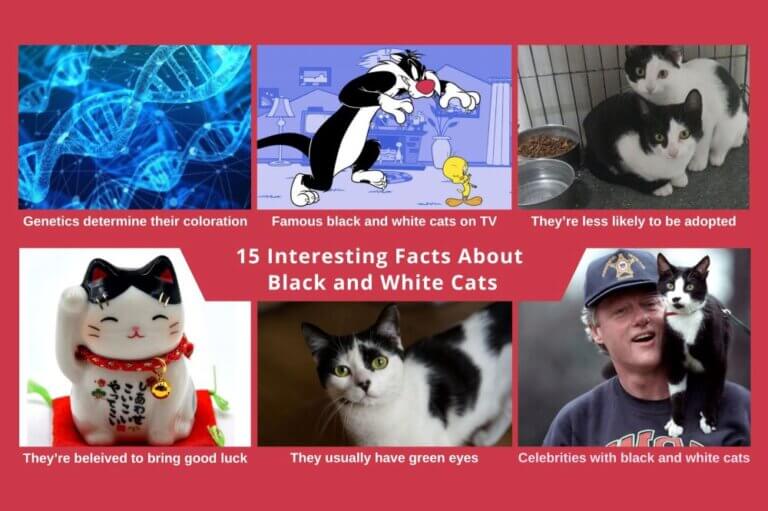

Written and verified by the biologist Georgelin Espinoza Medina
The pattern of black and white cats – also known as bicolor cats – is random. Their spotted pattern catches anyone’s attention. This coloration is exhibited by several breeds, such as Maine coon, munchkin, manx, and Cymric. In addition to this, they have particular traits that differentiate them from other kinds of cats.
Do you want to know what their characteristics are and curious facts about them? If you have a black and white feline as a pet or you’re thinking of adopting one, you can’t miss the following article. We’ll tell you everything you want to know about these animals, from how they get those shades to what they symbolize. Don’t miss a thing!
Interesting facts about black and white cats
1. Their genetics determine their color
You may have wondered why there are such dissimilar feline colors or patterns. It may also have come to your attention that there are even differences within the same litter of kittens. As with all animals, genetics are involved in color.
There are two basic pigments that provide coat color: Black (eumelanin) and orange (pheomelanin). The density of each and their distribution will determine the variety of colors we know.
But there aren’t only genes that determine coloration, but others that establish the distribution of pigments. Therefore, the color and patterns of the coat will depend on the type of gene they inherit from their parents.
2. They’re black with white spots
Although many may believe otherwise, these felines are black, and their spots are white. In other words, they’re not white with black spots. White is, in fact, the absence of color. The current hypothesis states that the amount of white in kittens is determined by mutation in the KIT gene with two alleles, S and s, and the genotypes SS, Ss, and ss.
However, a recent paper reported in the journal Genes suggested that there are other factors involved in the inheritance of the amount of white in cats. It’s assumed that there may be unknown mutations in the KIT gene, as well as in other genes and even interactions between them. In any case, their coloration is more complex than people think.
3. There are different patterns of spots
According to their quantity and distribution, it’s possible to categorize the spots in different patterns for bicolor cats. According to the International Cat Federation, we can distinguish the following:
- Van: These cats have white on more than 75% of their body. On the face, they bear two dark patches that are separated by white, and their tail is also solid in color. They may have some patches of color irregularly distributed on their body.
- Harlequin: These cats have white on between 50 and 75% of their body. They have color on their tail and several patches on the rest of the coat.
- Bicolor: Between 25% and 50% of their body is white. Generally, they have white on their face, legs, chest, and stomach.
- With an unspecific amount of white: These cats usually have less than 25% white in their coat.
Other color patterns
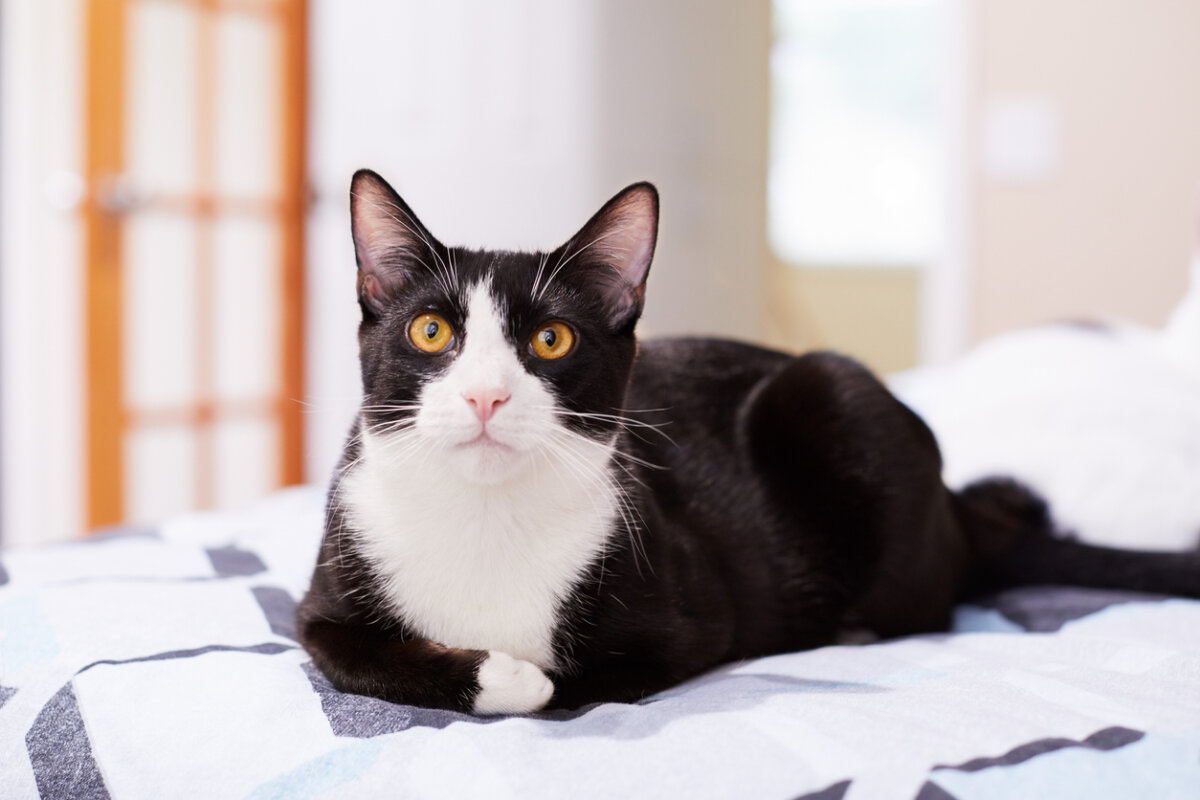
In addition to these accepted patterns, it’s possible to find others. Therefore, in black and white cats, you can find the patterns mentioned below:
- Tuxedo: It’s common to find black and white cats with this pattern of spots. It’s characterized by a white spot in the center of the face that goes down towards the chest. This gives them the appearance of wearing a suit. Also, they may have white paws.
- Mask and mantle: The white is on the lower part of the body. Above, they have a dark color as if they were wearing a mantle, which is usually accompanied by a mask.
- Cap and saddle: Instead of having a full black mask, the dark spot starts at the level of their eyes and extends to their back. Unlike the previous pattern, the amount of white is greater.
- Medallion or locket: In this case, the white spot is only restricted to a small patch in the center of the chest. The rest of the body is entirely black.
4. They may have a common personality
The color of a cat’s coat not only indicates the involvement of certain genes but can also determine the temperament of the cat. That is, there are personality differences depending on their coloration.
As suggested by the journal Animals, this relationship may occur because the pigment melanin shares a synthesis pathway with certain hormones and neurotransmitters. In the case of bicolor cats, caregivers often find that they possess the following traits:
- Active
- Bold
- Friendly
- Tolerant
- Stubborn
But also, black and white cats are often described as more aggressive toward people. However, in general, the personality of each feline will vary according to other factors, just as it does in people. Therefore, these analyses aren’t definitive.
5. The myth that they were worshipped by the Egyptians
It’s not news that the Egyptians worshipped felines. Cats in Ancient Egypt were worshipped as gods. Therefore, there’s a myth that most of them were black and white.
However, it’s most likely that the cats domesticated by them were African wild cats (Felis silvestris lybica). Therefore, it is more certain that they would have had brindle rather than bicolor coats.
6. There are several breeds that have these colors
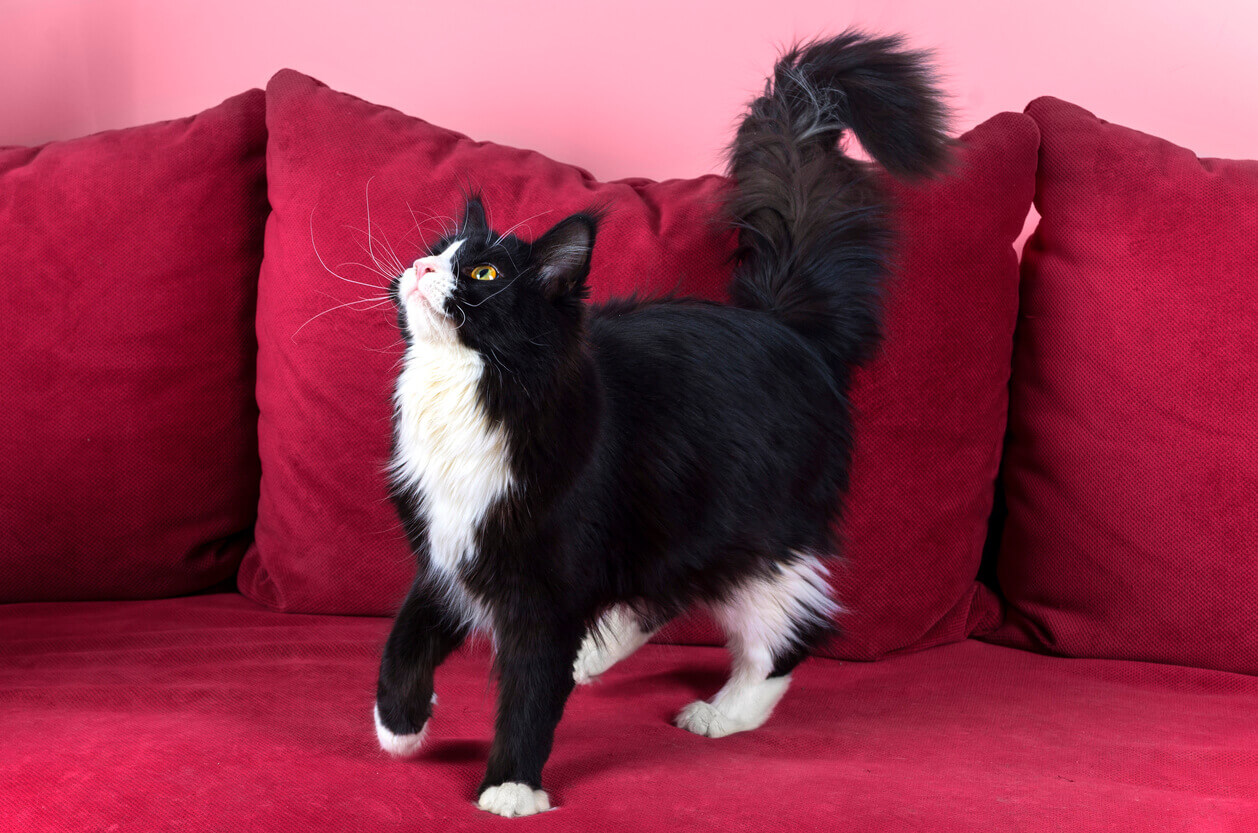
Black and white cats aren’t a particular breed. In fact, there are several breeds that have coats in these shades, with varying patterns of white spots. Some of them are mentioned below:
- Maine coon: These are one of the largest cat breeds, so they can weigh up to 22 pounds. This long-haired American cat has a variety of about 75 color combinations, such as black and white.
- Cymric cats: These cats usually have no tail, although others have a small tail. They have a medium size with long hair and varied colors, bicolor or tricolor.
- Japanese bobtail: These affectionate and energetic cats are characterized by a short tail with one or more curves and longer hind legs. They can have long or short hair in different colors, such as solid, calico, or bicolor.
- Oriental shorthair: Oriental shorthairs come in hundreds of combinations and patterns, including black and white. They’re members of the Siamese group of breeds, with slender bodies and flared ears.
- Munchkin cats: These cats are characterized by their low stature and short legs. They can have short plush or semi-long silky hair and a great variety of shades in their coat, such as black and white.
- Manx cats: This is an ancient breed from Ireland that’s characterized by the fact that many of its specimens have no tail or a short tail. The coat is short or long and dense in a wide variety of shades.
- Cornish rex: With large ears and a curved profile, this is an English breed noted for its high cheekbones and sunken cheeks. Its short, curly coat can be unicolor or with combinations of spots in various shades.
In addition to these described breeds, there are others that can present this black and white coloration. Among them are the Turkish van cat, the American shorthair cat, and the British shorthair cat.
7. Black and white cats that appear in literature
The fame of these small black and white felines reached literature. For example, in the book The Cat in the Hat (1957) by Dr. Seuss, the main character is a tuxedo cat. What’s more, the story has been adapted for television and film.
Similarly, black and white cats appear T. S. Eliot’s Old Possum’s Book of Practical Cats (1939). In particular, Eliot groups them into a fictitious breed, the jellicle. Notable among them is the character of Mr. Mistoffelees, one of the main characters in the musical Cats, which is an adaptation of the play.
8. Black and white cats on television
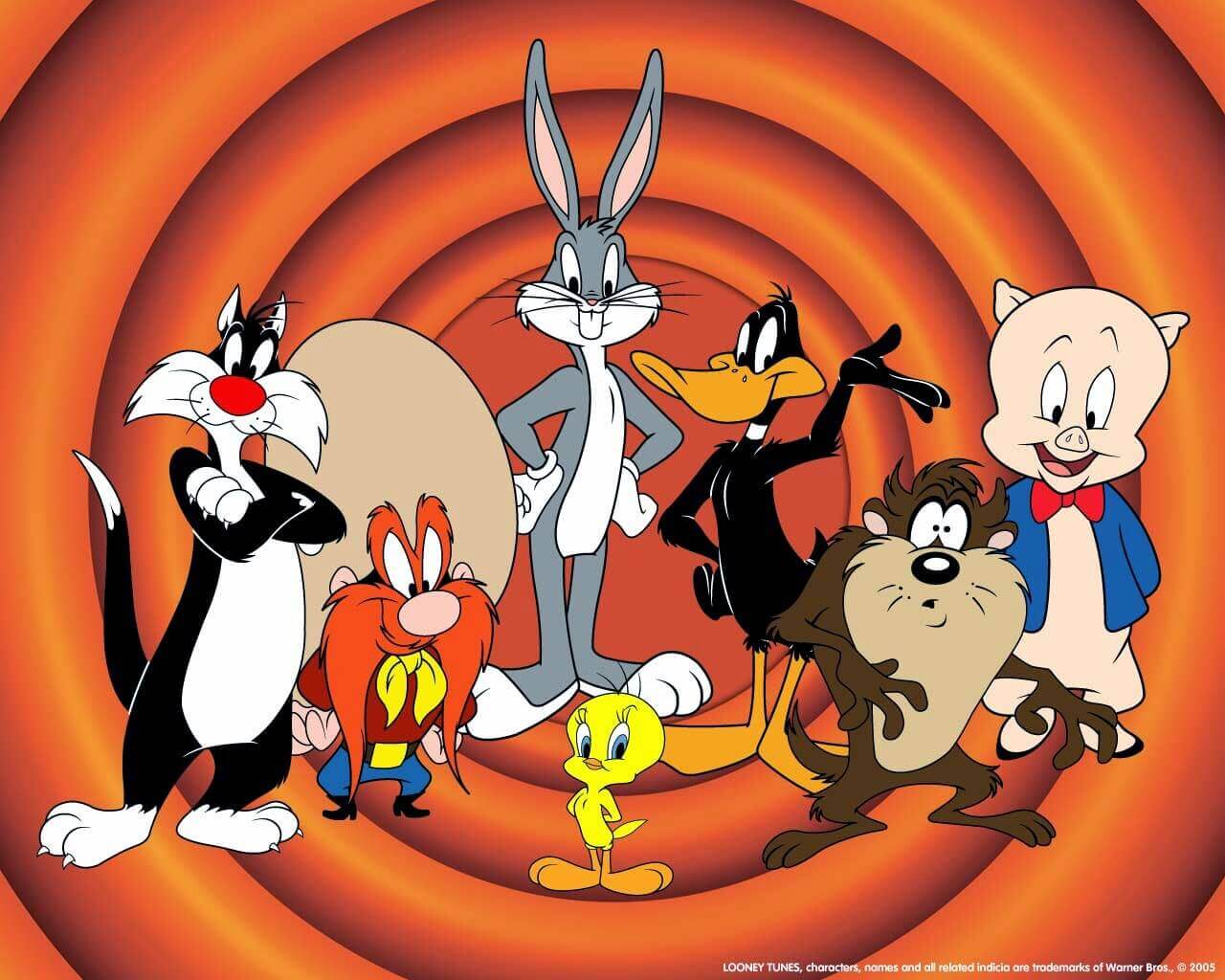
Bicolor cats in black and white tones are also famous in cartoons. An example of this is Felix the cat. The same goes for Sylvester and Penelope, characters from the Looney Tunes. All three have patterns with black masks on their fur, and Sylvester and Penelope may be considered tuxedo cats.
9. Celebrity black and white cats
Beyond the famous felines in television, movies, or literature, there have also been famous black and white cats in real life. One case was Socks, the tuxedo-patterned puss of the Clinton family who lived for 20 years.
Another famous tuxedo kitty, whose story is a curious one, was Tuxedo Stan, who tried to run for mayor in Halifax, Canada. His guardians’ idea was to raise awareness about the number of feral cats in his municipality.
Finally, Simon was another black and white cat who served on the British Royal Navy ship the HMS Amethyst. He received medals and honors for killing a plague of rats while on board, surviving a shell, and cheering up the crew.
10. They symbolize harmony
There’s a belief that cats with these colors unite the best of two worlds. And it’s clear where this assumption comes from. White cats are associated with innocence and purity, good luck, and protection.
Conversely, in many cultures, black cats have been associated with bad luck and evil for centuries. Although there’s no justified reason, superstitious people have a certain prejudice toward them.
Indeed, the coming together of these two colors in the fur of a single feline is often thought to create a balance between the two beliefs. Therefore, cats spotted with white would represent this polarity that exists in the world. What do you think?
11. Black and white cats are believed to bring good luck
Related to the above, unlike their black relatives and more closely related to their white relatives, white cats with black are considered good luck charms. Therefore, many people relate them to symbols of prosperity.
Perhaps it’s due to the stories of some well-known cats of that color, such as the aforementioned Simon, who have helped people in times of need. The reason is unknown, but beliefs link them with protection against bad energies.
12. There’s a Celtic legend about black and white cats
As with many animals, there are legends that deal with their loyalty to people. In this case, moreover, this Celtic story teaches about the origin of black and white cats. The story tells the life of Buigh, a black cat who adored her caretaker.
One day, the man went out to sea to sail and left the cat in the care of her mother. Unfortunately, the woman was informed that her son had died in a storm. So Buigh decided to go all along the coast in search of him, until, tired, she begged the sea to take her back to him.
Thankfully, she was swept away by a wave, and when she awoke, she was standing next to her caretaker. He had lost his memory in the accident and was able to regain it as soon as he saw the cat, although she was different.
The ocean had granted her the white color of her foam on her body as a souvenir. Since then, there have been black and white cats.
13. They usually have green eyes
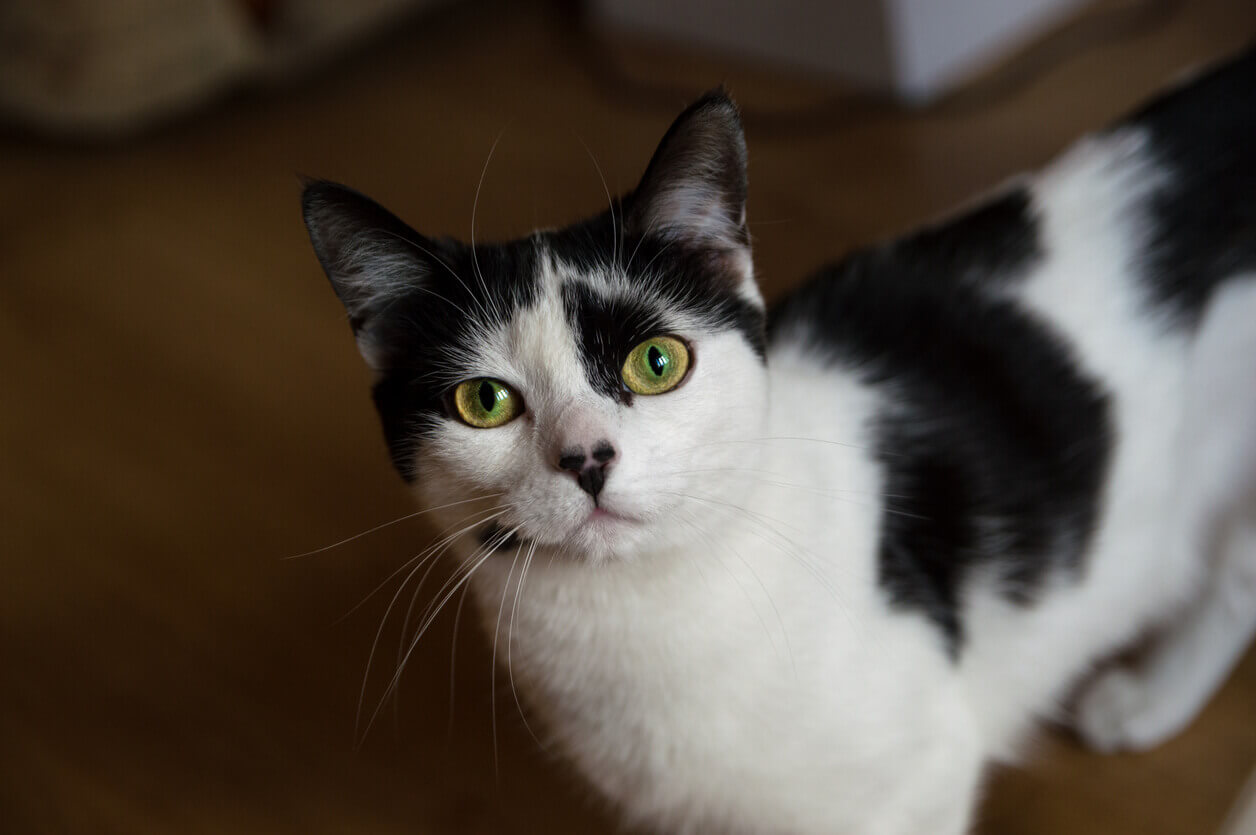
Although it’s not an exclusive characteristic of bicolor cats and nor is it a norm, those with black and white in their fur usually have green eyes. But it’s also possible to find some with light blue or blue eyes.
14. Black and white cats are less likely to be adopted
Although they are very cute and cuddly, these cats are less likely to be adopted than their peers. It may seem like just a belief, but it’s an issue that has been studied.
The Journal of Applied Animal Welfare Science indicated that they spend more time in some shelters than other cats before being adopted. For example, people often adopt tabby cats before tuxedo-patterned cats.
15. Coloration isn’t related to a cat’s sex
Tricolor cats are those with orange or red, black, and white shades. In their case, it’s very rare for them to be males. That’s why, in general, if you see a cat of this color, it’s most likely to be female.
On the contrary, the same doesn’t happen with cats with black and white fur. Therefore, it’s possible to find black and white cats of both sexes.
Were you surprised by any of these interesting facts about black and white cats?
The coloring of each feline gives it particular characteristics. In this case, white cats with black spots stand out for the 15 singularities we mentioned above. Did you have any idea that the spots are white and not the other way around? Did you know that these kitties tend to be less adopted than cats of other colors?
As a bonus fact, besides these curiosities, these cats have no particular care requirements. As they’re not a breed per se but rather a color pattern that’s present in several breeds, you must take into account the requirements of each one in particular. In general, this usually implies a good diet, attention, entertainment, and affection.
The pattern of black and white cats – also known as bicolor cats – is random. Their spotted pattern catches anyone’s attention. This coloration is exhibited by several breeds, such as Maine coon, munchkin, manx, and Cymric. In addition to this, they have particular traits that differentiate them from other kinds of cats.
Do you want to know what their characteristics are and curious facts about them? If you have a black and white feline as a pet or you’re thinking of adopting one, you can’t miss the following article. We’ll tell you everything you want to know about these animals, from how they get those shades to what they symbolize. Don’t miss a thing!
Interesting facts about black and white cats
1. Their genetics determine their color
You may have wondered why there are such dissimilar feline colors or patterns. It may also have come to your attention that there are even differences within the same litter of kittens. As with all animals, genetics are involved in color.
There are two basic pigments that provide coat color: Black (eumelanin) and orange (pheomelanin). The density of each and their distribution will determine the variety of colors we know.
But there aren’t only genes that determine coloration, but others that establish the distribution of pigments. Therefore, the color and patterns of the coat will depend on the type of gene they inherit from their parents.
2. They’re black with white spots
Although many may believe otherwise, these felines are black, and their spots are white. In other words, they’re not white with black spots. White is, in fact, the absence of color. The current hypothesis states that the amount of white in kittens is determined by mutation in the KIT gene with two alleles, S and s, and the genotypes SS, Ss, and ss.
However, a recent paper reported in the journal Genes suggested that there are other factors involved in the inheritance of the amount of white in cats. It’s assumed that there may be unknown mutations in the KIT gene, as well as in other genes and even interactions between them. In any case, their coloration is more complex than people think.
3. There are different patterns of spots
According to their quantity and distribution, it’s possible to categorize the spots in different patterns for bicolor cats. According to the International Cat Federation, we can distinguish the following:
- Van: These cats have white on more than 75% of their body. On the face, they bear two dark patches that are separated by white, and their tail is also solid in color. They may have some patches of color irregularly distributed on their body.
- Harlequin: These cats have white on between 50 and 75% of their body. They have color on their tail and several patches on the rest of the coat.
- Bicolor: Between 25% and 50% of their body is white. Generally, they have white on their face, legs, chest, and stomach.
- With an unspecific amount of white: These cats usually have less than 25% white in their coat.
Other color patterns

In addition to these accepted patterns, it’s possible to find others. Therefore, in black and white cats, you can find the patterns mentioned below:
- Tuxedo: It’s common to find black and white cats with this pattern of spots. It’s characterized by a white spot in the center of the face that goes down towards the chest. This gives them the appearance of wearing a suit. Also, they may have white paws.
- Mask and mantle: The white is on the lower part of the body. Above, they have a dark color as if they were wearing a mantle, which is usually accompanied by a mask.
- Cap and saddle: Instead of having a full black mask, the dark spot starts at the level of their eyes and extends to their back. Unlike the previous pattern, the amount of white is greater.
- Medallion or locket: In this case, the white spot is only restricted to a small patch in the center of the chest. The rest of the body is entirely black.
4. They may have a common personality
The color of a cat’s coat not only indicates the involvement of certain genes but can also determine the temperament of the cat. That is, there are personality differences depending on their coloration.
As suggested by the journal Animals, this relationship may occur because the pigment melanin shares a synthesis pathway with certain hormones and neurotransmitters. In the case of bicolor cats, caregivers often find that they possess the following traits:
- Active
- Bold
- Friendly
- Tolerant
- Stubborn
But also, black and white cats are often described as more aggressive toward people. However, in general, the personality of each feline will vary according to other factors, just as it does in people. Therefore, these analyses aren’t definitive.
5. The myth that they were worshipped by the Egyptians
It’s not news that the Egyptians worshipped felines. Cats in Ancient Egypt were worshipped as gods. Therefore, there’s a myth that most of them were black and white.
However, it’s most likely that the cats domesticated by them were African wild cats (Felis silvestris lybica). Therefore, it is more certain that they would have had brindle rather than bicolor coats.
6. There are several breeds that have these colors

Black and white cats aren’t a particular breed. In fact, there are several breeds that have coats in these shades, with varying patterns of white spots. Some of them are mentioned below:
- Maine coon: These are one of the largest cat breeds, so they can weigh up to 22 pounds. This long-haired American cat has a variety of about 75 color combinations, such as black and white.
- Cymric cats: These cats usually have no tail, although others have a small tail. They have a medium size with long hair and varied colors, bicolor or tricolor.
- Japanese bobtail: These affectionate and energetic cats are characterized by a short tail with one or more curves and longer hind legs. They can have long or short hair in different colors, such as solid, calico, or bicolor.
- Oriental shorthair: Oriental shorthairs come in hundreds of combinations and patterns, including black and white. They’re members of the Siamese group of breeds, with slender bodies and flared ears.
- Munchkin cats: These cats are characterized by their low stature and short legs. They can have short plush or semi-long silky hair and a great variety of shades in their coat, such as black and white.
- Manx cats: This is an ancient breed from Ireland that’s characterized by the fact that many of its specimens have no tail or a short tail. The coat is short or long and dense in a wide variety of shades.
- Cornish rex: With large ears and a curved profile, this is an English breed noted for its high cheekbones and sunken cheeks. Its short, curly coat can be unicolor or with combinations of spots in various shades.
In addition to these described breeds, there are others that can present this black and white coloration. Among them are the Turkish van cat, the American shorthair cat, and the British shorthair cat.
7. Black and white cats that appear in literature
The fame of these small black and white felines reached literature. For example, in the book The Cat in the Hat (1957) by Dr. Seuss, the main character is a tuxedo cat. What’s more, the story has been adapted for television and film.
Similarly, black and white cats appear T. S. Eliot’s Old Possum’s Book of Practical Cats (1939). In particular, Eliot groups them into a fictitious breed, the jellicle. Notable among them is the character of Mr. Mistoffelees, one of the main characters in the musical Cats, which is an adaptation of the play.
8. Black and white cats on television

Bicolor cats in black and white tones are also famous in cartoons. An example of this is Felix the cat. The same goes for Sylvester and Penelope, characters from the Looney Tunes. All three have patterns with black masks on their fur, and Sylvester and Penelope may be considered tuxedo cats.
9. Celebrity black and white cats
Beyond the famous felines in television, movies, or literature, there have also been famous black and white cats in real life. One case was Socks, the tuxedo-patterned puss of the Clinton family who lived for 20 years.
Another famous tuxedo kitty, whose story is a curious one, was Tuxedo Stan, who tried to run for mayor in Halifax, Canada. His guardians’ idea was to raise awareness about the number of feral cats in his municipality.
Finally, Simon was another black and white cat who served on the British Royal Navy ship the HMS Amethyst. He received medals and honors for killing a plague of rats while on board, surviving a shell, and cheering up the crew.
10. They symbolize harmony
There’s a belief that cats with these colors unite the best of two worlds. And it’s clear where this assumption comes from. White cats are associated with innocence and purity, good luck, and protection.
Conversely, in many cultures, black cats have been associated with bad luck and evil for centuries. Although there’s no justified reason, superstitious people have a certain prejudice toward them.
Indeed, the coming together of these two colors in the fur of a single feline is often thought to create a balance between the two beliefs. Therefore, cats spotted with white would represent this polarity that exists in the world. What do you think?
11. Black and white cats are believed to bring good luck
Related to the above, unlike their black relatives and more closely related to their white relatives, white cats with black are considered good luck charms. Therefore, many people relate them to symbols of prosperity.
Perhaps it’s due to the stories of some well-known cats of that color, such as the aforementioned Simon, who have helped people in times of need. The reason is unknown, but beliefs link them with protection against bad energies.
12. There’s a Celtic legend about black and white cats
As with many animals, there are legends that deal with their loyalty to people. In this case, moreover, this Celtic story teaches about the origin of black and white cats. The story tells the life of Buigh, a black cat who adored her caretaker.
One day, the man went out to sea to sail and left the cat in the care of her mother. Unfortunately, the woman was informed that her son had died in a storm. So Buigh decided to go all along the coast in search of him, until, tired, she begged the sea to take her back to him.
Thankfully, she was swept away by a wave, and when she awoke, she was standing next to her caretaker. He had lost his memory in the accident and was able to regain it as soon as he saw the cat, although she was different.
The ocean had granted her the white color of her foam on her body as a souvenir. Since then, there have been black and white cats.
13. They usually have green eyes

Although it’s not an exclusive characteristic of bicolor cats and nor is it a norm, those with black and white in their fur usually have green eyes. But it’s also possible to find some with light blue or blue eyes.
14. Black and white cats are less likely to be adopted
Although they are very cute and cuddly, these cats are less likely to be adopted than their peers. It may seem like just a belief, but it’s an issue that has been studied.
The Journal of Applied Animal Welfare Science indicated that they spend more time in some shelters than other cats before being adopted. For example, people often adopt tabby cats before tuxedo-patterned cats.
15. Coloration isn’t related to a cat’s sex
Tricolor cats are those with orange or red, black, and white shades. In their case, it’s very rare for them to be males. That’s why, in general, if you see a cat of this color, it’s most likely to be female.
On the contrary, the same doesn’t happen with cats with black and white fur. Therefore, it’s possible to find black and white cats of both sexes.
Were you surprised by any of these interesting facts about black and white cats?
The coloring of each feline gives it particular characteristics. In this case, white cats with black spots stand out for the 15 singularities we mentioned above. Did you have any idea that the spots are white and not the other way around? Did you know that these kitties tend to be less adopted than cats of other colors?
As a bonus fact, besides these curiosities, these cats have no particular care requirements. As they’re not a breed per se but rather a color pattern that’s present in several breeds, you must take into account the requirements of each one in particular. In general, this usually implies a good diet, attention, entertainment, and affection.
All cited sources were thoroughly reviewed by our team to ensure their quality, reliability, currency, and validity. The bibliography of this article was considered reliable and of academic or scientific accuracy.
- Brown, W. P., & Morgan, K. T. (2015). Age, breed designation, coat color, and coat pattern influenced the length of stay of cats at a no-kill shelter. Journal of Applied Animal Welfare Science, 18(2), 169-80. https://www.tandfonline.com/doi/abs/10.1080/10888705.2014.971156
- Fédération Internationale Féline. (s. f.). Breed Standars. Colour varieties with white. http://fifeweb.org/wp/breeds/breeds_prf_stn.php
- González-Ramírez, M. T., & Landero-Hernández, R. (2022). Cat Coat Color, Personality Traits and the Cat-Owner Relationship Scale: A Study with Cat Owners in Mexico. Animals, 12(8), 1030. https://www.mdpi.com/2076-2615/12/8/1030
- Górska, A., Drobik-Czwarno, W., Górska, A., & Bryś, J. (2022). Genetic Determination of the Amount of White Spotting: A Case Study in Siberian Cats. Genes, 13(6), 1006. https://www.ncbi.nlm.nih.gov/pmc/articles/PMC9223243/
- Jones, H. D., & Hart, C. L. (2020). Black Cat Bias: Prevalence and Predictors. Psychological Reports, 123(4), 1198-1206. https://pubmed.ncbi.nlm.nih.gov/31033416/
- Segura, J. C., Magaña, M. J., Santos, R. R., & Ek, M. E. (2020). Variedades de coloración en pelaje de mininos como respuesta a la expresión genética. Bioagrociencias, 13(2), 13-19. https://www.revista.ccba.uady.mx/ojs/index.php/BAC/article/view/3510
- Stelow, E. A., Bain, M. J., & Kass, P. H. (2016). The Relationship Between Coat Color and Aggressive Behaviors in the Domestic Cat. Journal of Applied Animal Welfare Science, 19(1), 1-15. https://pubmed.ncbi.nlm.nih.gov/26467020/
- The Cat Fanciers’ Association. (s. f.). About the American Shorthair. Consultado el 25 de octubre de 2023. https://cfa.org/american-shorthair/
- The Cat Fanciers’ Association. (s. f.). About the British Shorthair. Consultado el 25 de octubre de 2023. https://cfa.org/british-shorthair/
- The Cat Fanciers’ Association. (s. f.). About the Cornish Rex. Consultado el 28 de octubre de 2023. https://cfa.org/cornish-rex/
- The Cat Fanciers’ Association. (s. f.). About the Japanese Bobtail. Consultado el 28 de octubre de 2023. https://cfa.org/japanese-bobtail/
- The Cat Fanciers’ Association. (s. f.). About the Maine Coon. Consultado el 25 de octubre de 2023. https://cfa.org/maine-coon-cat/
- The Cat Fanciers’ Association. (s. f.). About the Manx. Consultado el 28 de octubre de 2023. https://cfa.org/manx/
- The Cat Fanciers’ Association. (s. f.). About the Turkish Van. Consultado el 25 de octubre de 2023. https://cfa.org/turkish-van/
- The International Cat Association. (13 de agosto de 2018). Munchkin Breed. TICA. https://www.tica.org/breeds/browse-all-breeds?view=article&id=857:munchkin-breed&catid=79
- The International Cat Association. (29 de abril de 2019). The Oriental Shorthair Breed. TICA. https://www.tica.org/breeds/browse-all-breeds?view=article&id=1292:the-oriental-shorthair-breed&catid=48
This text is provided for informational purposes only and does not replace consultation with a professional. If in doubt, consult your specialist.








